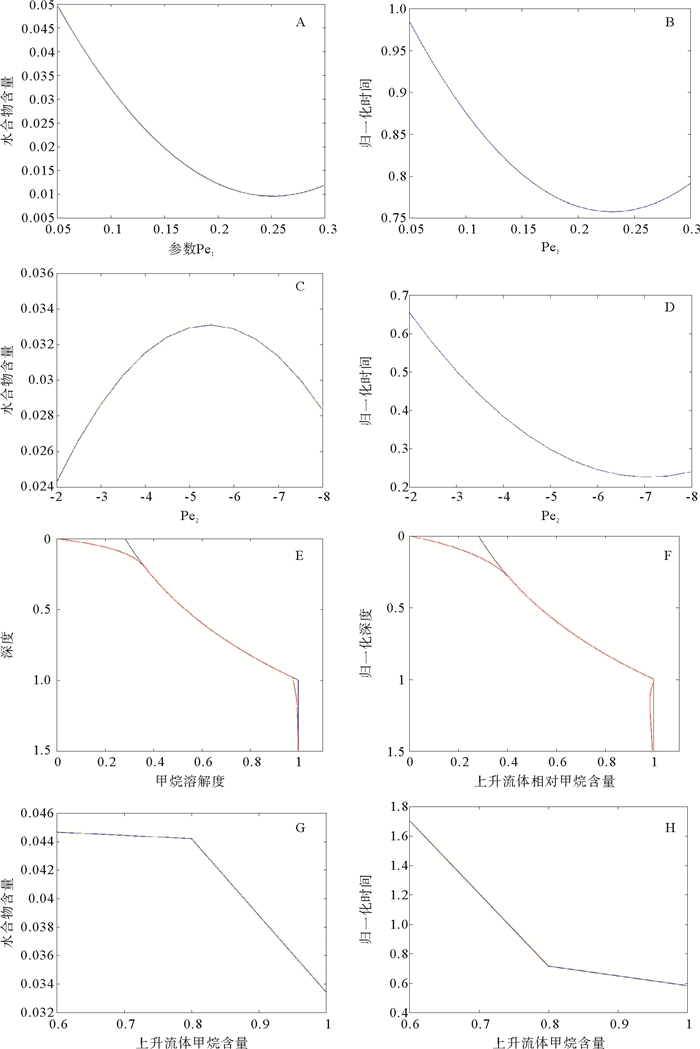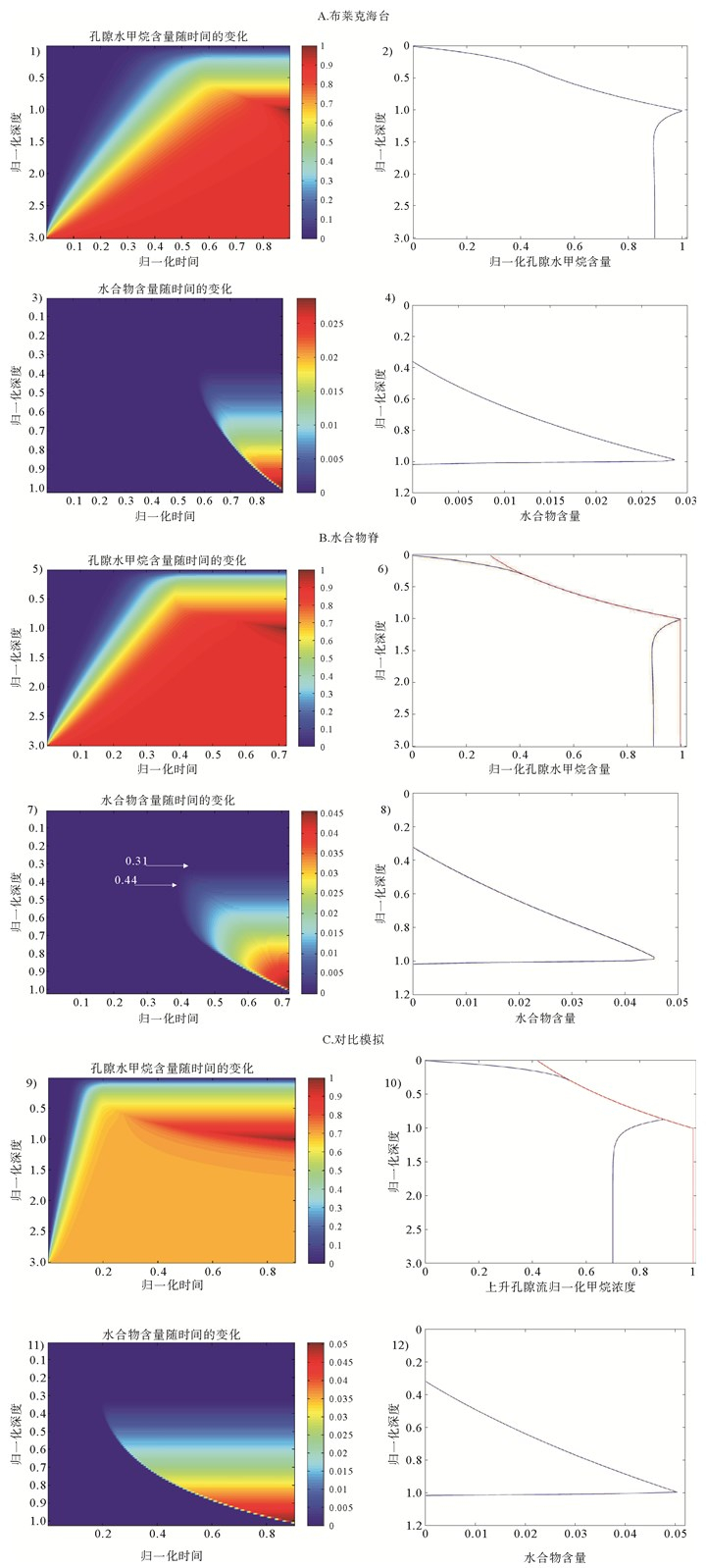MATHEMATICAL SIMULATION FOR SUBMARINE GAS HYDRATE FORMATION: UPON THE ASSUMPTION OF UPWARD ADVECTION OF METHANE-BEARING POREWATER
-
摘要:
为深入了解深部上升流体供应甲烷的海底沉积环境中天然气水合物的形成和聚集过程,综合沉积作用、深部上升甲烷流体的对流和扩散作用、甲烷溶解度控制水合物形成等物理过程,建立了天然气水合物形成过程的数学模型,研究水合物在空间和时间尺度上的形成过程。模型通过3个无量纲参数(沉积压实引起的孔隙流体对流与扩散的比率Pe1、深部流体向上对流传输与扩散的比率Pe2、深部上升流体的甲烷含量$\widetilde C_{m, ext}^{_{_{\rm{l}}}}$),形象地描述了天然气水合物在海底沉积中的聚集过程。数值模拟研究表明,天然气水合物首先在稳定带内上部某一位置形成,随后由于沉积作用向下延伸而在稳定带底部形成水合物;水合物演化时间与Pe1、Pe2及$\widetilde C_{m, ext}^{_{_{\rm{l}}}}$呈负相关;水合物含量与Pe1、$\widetilde C_{m, ext}^{_{_{\rm{l}}}}$负相关,而与Pe2正相关。甲烷溶解度曲线对水合物形成和分布有重要影响,但深部上升流体的甲烷含量、上升流体的通量决定了整个水合物系统甲烷量的输入和输出,是海底天然气水合物形成的主要控制因素。
Abstract:Sea bottom gas hydrate (GH) may be formed by porewater advecting upward from deep. In order to understand this process, we developed a non-dimensional mathematical model, combining together the sedimentary process, methane transporting by convection and diffusion of fluid upward, and methane solubility, for study of GH formation and accumulation in a temporal and spatial framework. The model describes the process of GH formation and accumulation with 3 dimensionless parameters, Pe1, Pe2, $\widetilde C_{m, ext}^{_{_{\rm{l}}}}$, which represents respectively the sedimentary process, porewater advection upward from deep and methane content in the fluid. GH emerges in the upper gas hydrate stability zone (GHSZ) first, then grows downward within the continuous sedimentary deposits, and extends eventually to the base of GHSZ. There is a negative correlation between GH evolution time and the three parameters of Pe1, Pe2, $\widetilde C_{m, ext}^{_{_{\rm{l}}}}$, and between GH concentration and Pe1, $\widetilde C_{m, ext}^{_{_{\rm{l}}}}$, but a positive correlation between GH concentration, evolution time and upward methane flux (Pe2 and $\widetilde C_{m, ext}^{_{_{\rm{l}}}}$). The methane solubility influences greatly on the GH formation and distribution. But the simulation results suggest that both the methane concentration of fluid flow from deep and its flux control the methane inputs and outputs of the hydrate system. They are not included in the solubility-curve. So we propose the methane concentration of porewater upward and its flux as controlling factors.
-

-
表 1 布莱克海台与水合物脊水合物形成过程数值模拟参数
Table 1. Parameters for simulation from Blake Platform and Hydrate Ridge
模型参数 布莱克海台 水合物脊 海底深度z/m 2781[1] 1311[20] 海底温度T/℃ 3.4[1] 2.7[20] 地温梯度G/℃·m-1 0.04[1] 0.054[20] 稳定带厚度Lz/m 450[3] 225[20] 沉积速度Vs/cm·ka-1 22[24] 25[20] 甲烷扩散系数Dm/m2·s-1 10-9[11] 10-9[11] 深部上升流体速度Vl,ext/mm·a-1 -0.26[20] -1[17] 沉积引起的孔隙流体通量Ul,sed/m·s-1 2.32×10-13 2.64×10-13 孔隙流体净通量Ul/m·s-1 -5.82×10-12 -2.22×10-11 Pe1 0.1 0.06 Pe2 -2.57 -5.16 $\widetilde C_{m, ext}^{_{_{\rm{l}}}}$ 0.9 0.9 -
[1] Paull C K, Matsumoto R, Wallace P J. Proceedings of the ocean drilling program, initial reports[R]. College Station, TX (Ocean Drilling Program), 1996, 164.
[2] 吴能友, 梁金强, 王宏斌, 等.海洋天然气水合物成藏系统研究进展[J].现代地质, 2008, 22(3): 356-362. http://d.old.wanfangdata.com.cn/Periodical/xddz200803003
WU Nengyou, LIANG Jinqiang, WANG Hongbin, et al. Marine gas hydrate system: state of the art (in Chinese) [J]. Geoscience, 2008, 22(13): 356-362. http://d.old.wanfangdata.com.cn/Periodical/xddz200803003
[3] Paull C K, Matsumoto R. Proceedings of the ocean drilling program, scientific results [R].College Station, TX (Ocean Drilling Program), 2000, 164: 3-10.
[4] Dickens G R. Rethinking the global carbon cycle with a large, dynamic and microbially mediated gas hydrate capacitor [J]. Earth and Planetary Science Letters, 2003, 213: 169-183. doi: 10.1016/S0012-821X(03)00325-X
[5] Tréhu A M, Long P E, Torres M E, et al. Three-dimensional distribution of gas hydrate beneath southern Hydrate Ridge: constraints from ODP Leg 204 [J]. Earth and Planetary Science Letters, 2004, 222: 845-862. doi: 10.1016/j.epsl.2004.03.035
[6] Hyndman R D, Davis E E. A mechanism for the formation of methane hydrate and seafloor bottom-simulating reflectors by vertical fluid expulsion [J]. Journal of Geophysical Research, 1992, 97(B5): 7025-7041. doi: 10.1029/91JB03061
[7] Rempel A W, Buffett B A. Formation and accumulation of gas hydrate in porous media [J]. Journal of Geophysical Research, 1997, 102(B5): 10151-10164. doi: 10.1029/97JB00392
[8] Rempel A W, Buffett B A. Mathematical models of gas hydrate accumulation [J]. Geological Society, London, Special Publications, 1998, 137(1): 63-74. doi: 10.1144/GSL.SP.1998.137.01.05
[9] Xu W Y, Ruppel C. Predicting the occurrence, distribution, and evolution of methane gas hydrate in porous marine sediments [J]. Journal of Geophysical Research-Solid Earth, 1999, 104(B3): 5081-5095. doi: 10.1029/1998JB900092
[10] Zatsepina O Y, Buffett B A. Thermodynamic conditions for the study of gas hydrates in the seafloor [J]. Journal of Geophysical Research, 1998, 103(B10): 24127-24139. doi: 10.1029/98JB02137
[11] Davie M K, Buffett B A. A numerical model for the formation of gas hydrate below the seafloor [J]. Journal of Geophysical Research-Solid Earth, 2001, 106(B1): 497-514. doi: 10.1029/2000JB900363
[12] Bhatnagar G, Chapman W G., Dickens G R, et al. Generalization of gas hydrate distribution and saturation in marine sediments by scaling of thermodynamic and transport processes [J]. American Journal of Science, 2007, 307: 861-900. doi: 10.2475/06.2007.01
[13] Haacke R R, Westbrook G K, Riley M S. Controls on the formation and stability of gas hydrate-related bottom-simulating reflectors (BSRs): A case study from the west Svalbard continental slope [J]. Journal of Geophysical Research, 2008, 113: B05104. http://cn.bing.com/academic/profile?id=2bf54aea3b4b5906f0345fbc097e4157&encoded=0&v=paper_preview&mkt=zh-cn
[14] Haacke R R, Westbrook G K, Hyndman R D. Gas hydrate, fluid flow and free gas: Formation of the bottom-simulating reflector [J]. Earth and Planetary Science Letters, 2007, 261(3-4): 407-420. doi: 10.1016/j.epsl.2007.07.008
[15] Egeberg P K, Dickens G R. Thermodynamic and pore water halogen constraints on hydrate distribution at ODP Site 997 (Blake Ridge) [J]. Chemical Geology, 1999, 153: 53-79. doi: 10.1016/S0009-2541(98)00152-1
[16] Davie M K, Zatsepina O Y, Buffett B A. Methane solubility in marine hydrate environments [J]. Marine Geology, 2004, 203(1-2): 177-184. doi: 10.1016/S0025-3227(03)00331-1
[17] Wang K, Hyndman R D, Davis E E. Thermal effects of sediment thickening and fluid expulsion in accretionary prisms-model and parameter analysis [J]. Journal of Geophysical Research, 1993, 98(6): 9975-9984. http://cn.bing.com/academic/profile?id=60c84627fccb80e80f2d07e8972cdc3b&encoded=0&v=paper_preview&mkt=zh-cn
[18] Dickens G R, Paull C K, Wallace P. Direct measurement of in situ methane quantities in a large gas-hydrate reservoir [J]. Nature, 1997, 385(6615): 426-428. doi: 10.1038/385426a0
[19] Torres M E, Wallman, K, Trehu A M, et al. Gas hydrate growth, methane transport, and chloride enrichment at the southern summit of Hydrate Ridge, Cascadia margin off Oregon [J]. Earth and Planetary Science Letters, 2004, 226: 225-241. doi: 10.1016/j.epsl.2004.07.029
[20] Haeckel M, Suess E, Wallman K, et al. Rising methane gas bubbles form massive hydrate layers at the seafloor [J]. Geochimica et Cosmochimica Acta, 2004, 68: 4335-4345. doi: 10.1016/j.gca.2004.01.018
[21] Wallmann K, Aloisi G, Obzhirov A, et al. Kinetics of organic matter degradation, microbial methane generation, and gas hydrate formation in anoxic marine sediments [J]. Geochimica et Cosmochimica Acta, 2006, 70(15): 3905-3927. doi: 10.1016/j.gca.2006.06.003
[22] Westbrook G K, Carson B, Musgrave R J, et al. Proceedings of the ocean drilling program, initial reports [R].College Station, TX (Ocean Drilling Program), 1994, 146.
http://www-odp.tamu.edu/publications/146_1_IR/VOLUME/CHAPTERS/146irpt1.pdf [23] Borowski W S, Paull C K, Ussler Ⅲ W. Marine pore-water sulfate profiles indicate in situ methane flux from underlying gas hydrate [J]. Geology, 1996, 24(7): 655-658. doi: 10.1130/0091-7613(1996)024<0655:MPWSPI>2.3.CO;2
[24] Davie M K, Buffett B A. A steady state model for marine hydrate formation: Constraints on methane supply from pore water sulfate profiles [J]. Journal of Geophysical Research-Solid Earth, 2003, 108(B10): 2495. http://cn.bing.com/academic/profile?id=7bbd3b4c84bfe1244db235a94e4789dd&encoded=0&v=paper_preview&mkt=zh-cn
[25] Kastner M, Kvenvolden K A, Whiticar M J, et al. Relation Between Pore Fluid Chemistry and Gas Hydrates Associated with Bottom-Simulating Reflectors at the Cascadia Margin, Sites 889 and 892 [C]//In: Carson B, Westbrook G K, Musgrave R J, Suess E, Eds. Proceedings of the Ocean Drilling Program, Scientific Results, 1995, 146: 175-187.
[26] Kvenvolden K A. Gas hydrates-geological perspective and global change [J]. Reviews of Geophysics, 1993, 31(2): 173-187. http://www.wanfangdata.com.cn/details/detail.do?_type=perio&id=756561cd96b062bf9ab8a8aaf8aba11d
[27] Paull C K, Ussler W I, Borowski W S. Natural gas hydrates, chapter sources of biogenic methane to form marine gas hydrates [J]. Annals of the New York Academy of Sciences, 1994, 715: 392-409. doi: 10.1111/j.1749-6632.1994.tb38852.x
[28] Pecher I A, Minshull T A, Singh S C, et al. Velocity structure of a bottom simulating reflector offshore Peru: Results from full waveform inversion [J]. Earth and Planetary Science Letters, 1996, 139(3-4): 459-469. doi: 10.1016/0012-821X(95)00242-5
[29] Huene R V, Pecher I A. Vertical tectonics and the origins of BSRs along the Peru margin [J]. Earth and Planetary Science Letters, 1999, 166(1-2): 47-55. doi: 10.1016/S0012-821X(98)00274-X
-




 下载:
下载:

